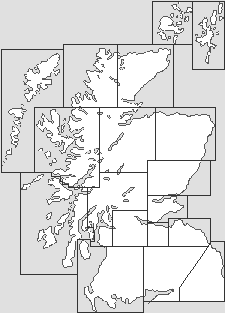 Looking Up the Steps from the Bottom of Mine Howe |
We first visited the mysterious Mine Howe in 2002, which is when most of the photographs on this page - including all the interior photographs - were taken. At some point since then Mine Howe has closed, apparently permanently, though we have been unable to discover anything definite about its future.
A revisit in September 2018 found the site abandoned, with the portacabin office in a poor state and the excavations overgrown. Mine Howe itself appeared still physically accessible, though the little hut that topped it off had gone. We had found Mine How to be a deeply (pun intended) unsettling place when we descended in 2002; and that was with electric lighting and the knowledge the structure was safe, stable and (relatively) dry. We decided against repeating the experience with no such safeguards in place: and we'd recommend against anyone else doing so either.
What follows is the text of the feature we published after our 2002 visit to Mine Howe. In reading it, please bear in mind that what we say has been overtaken by the subsequent closure.
Early in 1946 an excavation was carried out at an earth mound in Tankerness known as Mine Howe. A deep rock-built chamber was uncovered which was interpreted as the remains of an iron age broch, and the excavation was then filled in again.
In 1999 the local farmer, Douglas Paterson, rediscovered the entrance and cleared out the chamber once more. What he found was a passage that sank nearly vertically into the ground and was accessed by 29 steep stone steps. Half way down, these doubled back on themselves at a "landing", and at the bottom there was a very deep step into the bottom of the chamber. Two long low galleries extended outwards from the half way "landing".
In June 2000 the TV archeological programme Time Team came to Mine Howe to explore the structure. Thought drawing no firm conclusions about its purpose, they did work out how Mine Howe had been built: and to prove it they built a smaller version nearby. They dug a hole of the required depth before building the structure within it from above. The roof of the main chamber simply corbelled in from the walls and was capped off with a large flat stone. (Continues below image...)
 Entrance to Mine Howe in September 2018 |
Subsequent work has shown that Mine Howe is a very important site, even by Orkney's remarkable archeological standards. The central underground structure is believed to date back to the early Iron Age and have a ritual purpose. It was surrounded by a massive causewayed ditch. A settlement grew outside the ditch in the later Iron Age or the Pictish era and excavations continue to explore this further, with particular focus on evidence of metal working that has come to light.
Visitors are greeted at Mine Howe by an exhibition containing photographs and background about the rediscovery, the Time Team excavation and the more recent work on the site. Having toured the exhibition you are issued with a hard hat and proceed to the wooden structure protecting the entrance.
The maximum number of visitors allowed to descend into Mine Howe any one time is two, so at busy times you may need to join the informal queue on the grass outside. The reason for this restriction becomes clear as you enter Mine Howe. As you descend the steep steps you find yourself closely confined by the rather damp rock of the structure, guided by the string of lights wrapped around the handrail. Light coloured and non-washable clothing really isn't recommended.
The side galleries from the landing are easy to miss as you descend. Once in the cistern, or foot of the structure, you find that natural light and sound from the entrance have completely disappeared, leaving you in a damp netherworld that, though fascinating, would be difficult to call pleasant.
You ought to stop long enough to admire what you can see of the extremely impressive corbelled roof, 4m above the floor, but you will probably not want to hang around for long. Don't forget to peer into the galleries on your way up.
 Looking Up at the Corbelling |

|
|
|
Visitor InformationView Location on MapGrid Ref: HY 501 060 What3Words Location: ///chariots.drums.costumes |
 The Portacabin |
 The Exhibition |
 The Portacabin in 2018 |
 Overview of Site |
 Overview of Site in 2018 |
 Excavations |
 Excavations in 2018 |






